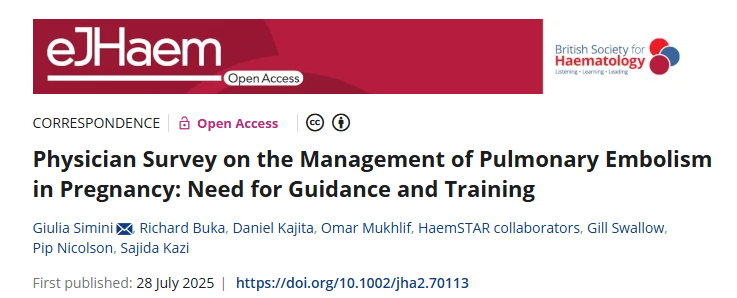
eJHaem Publication and MATRON Audit Spotlight Gaps in Pulmonary Embolism Care for Pregnant Patients
Giulia Simini, Haematology Resident at at University College London (UCL), has shared a post on Linkedin:
“New publication out in eJHaem:
‘Physician Survey on the Management of Pulmonary Embolism in Pregnancy: Need for Guidance and Training’
Our survey reveals significant challenges in managing pulmonary embolism (PE) during pregnancy —an area where uncertainty remains high. Key takeaways include:
- A pressing need for high-quality, real-world data on the management of intermediate- and high-risk PE in pregnancy
- Significant gaps in clinician training and limited access to advanced therapies
- Wide variability in clinical practice and perceptions of the usefulness of advanced interventions
- Uneven distribution and underutilization of Pulmonary Embolism Response Teams (PERTs)
In direct response to these findings, we launched MATRON – a national, multicenter audit focused on the management of high-risk and intermediate-high-risk PE in pregnancy.
By capturing real-world data across the UK, MATRON aims to fill critical evidence gaps and lay the groundwork for future clinical guidance. Results from first round of data collection will be shared soon.
A huge thank you to our collaborators and all the clinicians who contributed to this work.”
You can check the MATRON webpage here
Title: Physician Survey on the Management of Pulmonary Embolism in Pregnancy: Need for Guidance and Training
Authors: Giulia Simini, Richard Buka, Daniel Kajita, Omar Mukhlif, HaemSTAR collaborators, Gill Swallow, Pip Nicolson, Sajida Kazi

Read the full article here.
Stay informed with Hemostasis Today.
-
Dec 20, 2025, 18:30Kate Scrivener on Cochrane Review: 2025 Ends With a Big Milestone!
-
Dec 20, 2025, 18:15Shekher Bose on AstraZeneca’s Voluntary Withdrawal of Andexxa
-
Dec 20, 2025, 17:10Mina Adel Nagi on the Future of ESR Testing with HORIBA’s CoRA Technology
-
Dec 20, 2025, 16:50Geert Verheyden on Advancing Stroke Rehabilitation Through Collaboration and Innovation
-
Dec 20, 2025, 16:26Dirk Sibbing on Antithrombotic Drugs for ACS in Women
-
Dec 20, 2025, 16:13Akshat Jain Explains VWF/FVIII Prophylaxis in Children Under 6
-
Dec 20, 2025, 15:49Manuel Requena Shares The Results of the RESISTANT International Registry
-
Dec 20, 2025, 13:49Harshal Kale: Wishing Our Community a Bright Start to 2026
-
Dec 20, 2025, 12:23Healthcare is a Human Right: Strengthening Blood Donation in Armenia
